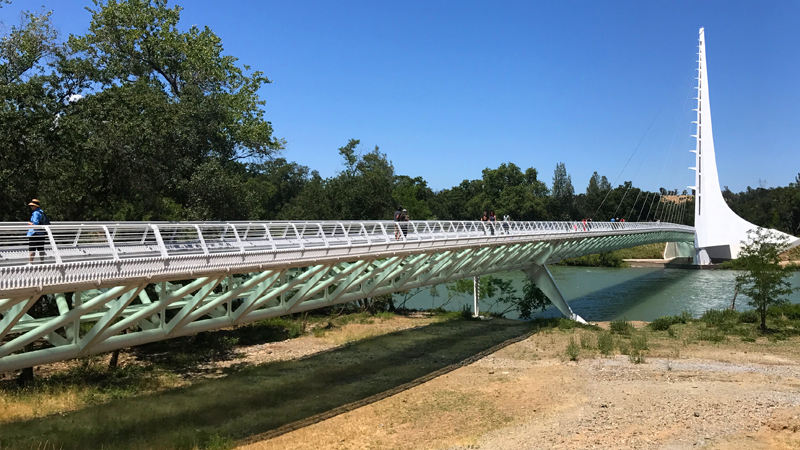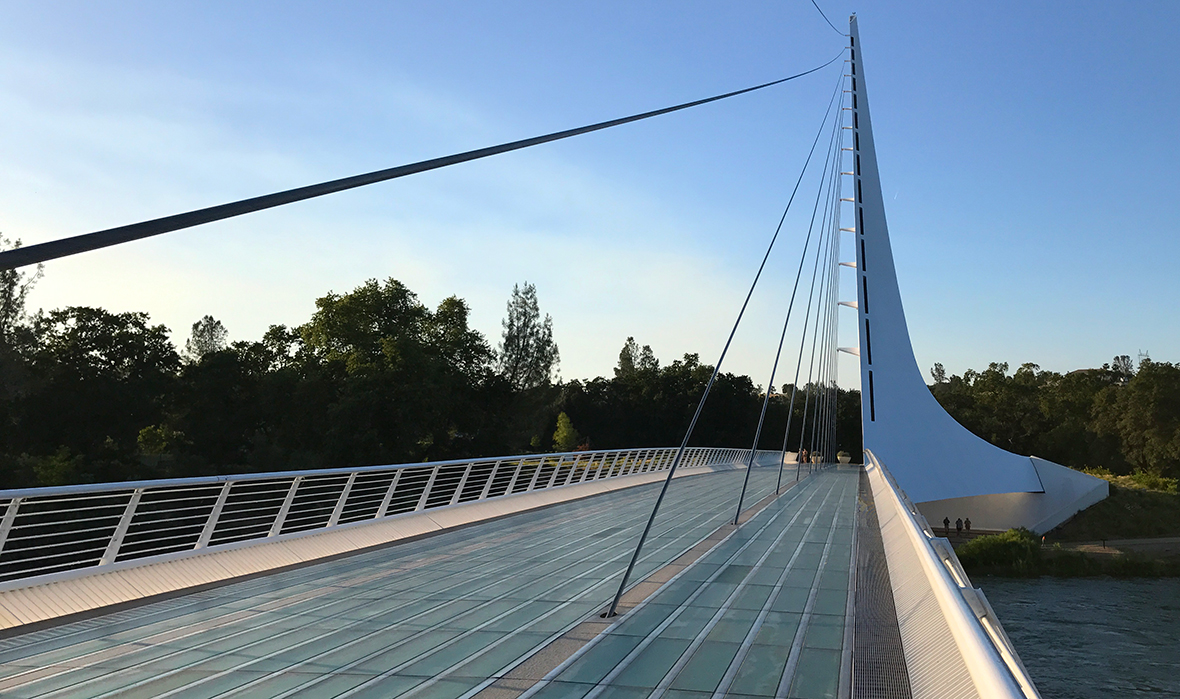
Set in a beautiful, natural, riparian habitat, the Sundial Bridge spans the Sacramento River in Redding, California. Designed by Spanish architect Santiago Calatrava, the Sundial Bridge, also called the Calatrava Bridge, and is one of the largest sundials in the world.
Completed in 2004 at a cost of almost $24 million, the bridge is a bridge for bicycles and pedestrians that forms a large sundial. At each end of the bridge, there are outdoor public plazas, with the northern plaza extending underneath the bridge to the edge of the Sacramento River.
The Sundial Bridge shadow traces an arc that is so big it can record time for only four hours a day, from 11:00 am to 3:00 pm. When visible, the shadow moves about one foot per minute, so you can see it move — which means you’re actually able to see the world.
Visiting The Sundial bridge
We arrived in Redding for our weekend of exploring Shasta Caverns and hiking McCloud Falls on a Friday evening, and because it was too late for a big adventure, we decided to head over to the Turtle Bay Exploration Park and check out the famous Sundial bridge.
Sundial Bridge is stunning. Surrounded by the rushing river, trees, and blue skies, the bridge, with a towering white pylon stretching into the air, makes a dramatic architectural statement. And, if you think the bridge is beautiful during the day, try checking it out at night when the glass deck tiles are lit from beneath, making the bridge glow with an aqua-blue light.
The glass and granite deck of the Sundial bridge stretches all the way across the river without ever touching the water — a design feature that contributes to the protection of the Sacramento River salmon spawning grounds beneath the bridge.
After snapping some photos of the bridge, we walked across it, taking in the majestic views of the river and looking up at the Sundial’s pylon. We then followed a trail down to the plaza below the bridge where we relaxed for a while enjoying the cool, shade. As the sun began to set, we walked through some of the McConnell Arboretum and Gardens, before heading back across the bridge.

About The Sundial Bridge
The design for the Redding Sundial Bridge was conceived by Spanish architect and engineer Santiago Calatrava. Calatrava has built bridges, airports, rail terminals, stadiums, and other structures around the world, including the PATH transportation terminal at the World Trade Center site in New York City, and the primary stadium for the 2004 Olympic Games in Athens, Greece. This is his first free-standing bridge in the United States.
The Sundial Bridge is a cantilever spar cable-stayed bridge. This bridge-style uses a 217 foot cantilever support tower that points north at a 42-degree angle and loaded by cable stays on only one side.
The bridge’s shadow is cast upon a large dial to the north of the bridge. It is exactly accurate on only one day in a year — the summer solstice. The tip of the shadow moves at approximately one foot per minute so you can actually see the Earth’s rotation with the naked eye.
Due to the sensitivity of the local riparian habitat, steel for the bridge was fabricated at a steel yard in Vancouver, Washington. A total of 18, 40-foot deck sections and 25 truck loads of pylon pieces were transported from Vancouver to Turtle Bay. Fourteen large pieces were shipped by barge to Vallejo and then trucked to Redding, sometimes taking up the entire freeway.
Sundial Bridge Statistics
- The bridge construction was completed and officially opened to the public July 4, 2004.
- The Sundial bridge weighs 3.2 million pounds and measures 700 feet long, 23 feet wide, 217 feet high (pylon).
- The bridge is a steel structure with galvanized steel cables, made of 580 tons of steel and 4,342 feet of cable.
- The foundation consists of 115 tons of rebar and 1,900 cubic yards of concrete.
- The superstructure consists of 400 tons of steel and a deck made with 200 tons of non-skid glass panels and granite accents.
- The McConnell Foundation, established in Redding in 1964, funded the majority of the bridge’s $24 million cost.
- The cable for the bridge was made in England. The dial of the sundial and plaza underneath are decorated with broken white tile from Spain. The deck’s translucent structural glass is from Quebec. The steel support structure of the bridge was made in Vancouver, Washington.
Know Before You Go
- The Sundial Bridge at Turtle Bay is located on the Sacramento River Trail at the Turtle Bay Exploration Park at 844 Sundial Bridge Drive, Redding, California 96003.
- The Sundial Bridge provides bike and pedestrian access to the north and south areas of the Turtle Bay Exploration Park, including art and history museums and the McConnell Arboretum and Gardens.
- The bridge is also the gateway to the Sacramento River Trail, a 35 mile long trail that extends along both sides of the river and connects the Sundial Bridge to the Shasta Dam.
- From the bridge, Mount Shasta is barely visible — Shasta Bally is visible to the West looking upstream.
- Due to it’s large size, the sundial shadow can record only four hours a day, from 11:00 am to 3:00 pm, and it is not accurate in the winter because of the size and reach of the shadow.
- The shadow cast is exactly accurate on only one day in a year — the summer solstice, June 20 or 21.








